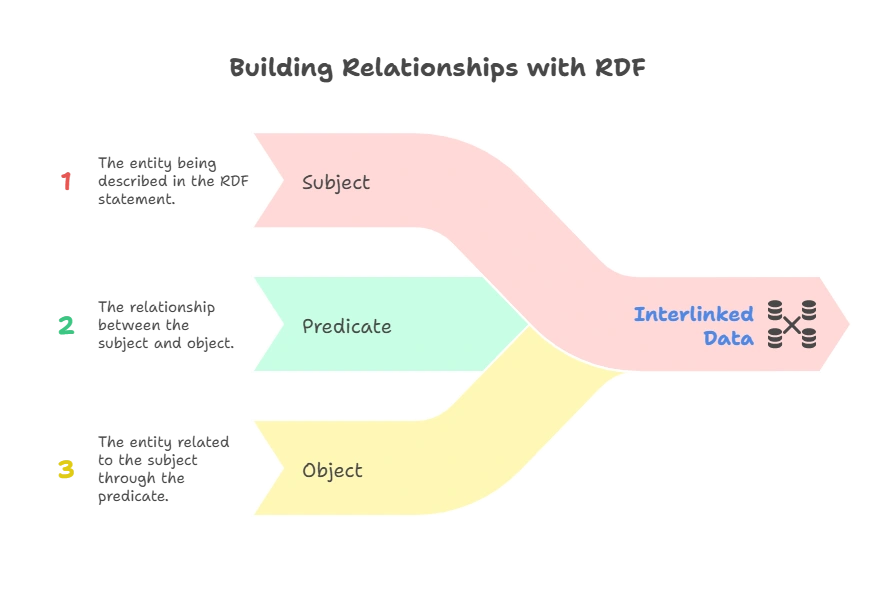RDF (Resource Description Framework in XML)
The Resource Description Framework (RDF) is a foundational technology for representing and sharing structured data on the web. RDF, designed by the World Wide Web Consortium (W3C), enables data interconnection by describing resources and their relationships in a standard format. In this chapter, we’ll explore RDF’s role in XML, its syntax, use cases, and applications.
Introduction to RDF
RDF provides a framework to represent information as simple “triples” in the form of subject-predicate-object statements. These triples form a graph that describes relationships among resources, making it possible to interlink data across various sources.
Example of RDF Triples:
- Subject: “Book”
- Predicate: “hasAuthor”
- Object: “Jane Doe”
The statement, “Book hasAuthor Jane Doe,” describes a relationship between a book and its author.

RDF and XML: The Connection
XML, as a flexible markup language, serves as one of the common serialization formats for RDF data. Using XML to represent RDF data leverages XML’s readability, ensuring interoperability across systems.
Key Aspects of RDF in XML
- Interoperability: XML provides a structured format that is widely compatible.
- Standardization: RDF/XML syntax adheres to W3C standards, making it a reliable way to encode linked data.
RDF Triples: Subject, Predicate, and Object
Each RDF triple has three components:
- Subject: The resource being described (e.g., “Book”).
- Predicate: The property or attribute of the resource (e.g., “hasAuthor”).
- Object: The value or entity related to the subject (e.g., “Jane Doe”).
RDF data is essentially a collection of these triples, allowing complex relationships between entities.
Example in RDF/XML Syntax:
<rdf:RDF xmlns:rdf="http://www.w3.org/1999/02/22-rdf-syntax-ns#">
<rdf:Description rdf:about="http://example.org/book1">
<dc:title xmlns:dc="http://purl.org/dc/elements/1.1/">Learning XML</dc:title>
<dc:creator xmlns:dc="http://purl.org/dc/elements/1.1/">Jane Doe</dc:creator>
</rdf:Description>
</rdf:RDF>
Explanation:
- The
<rdf:Description>element describes the resource. - Inside,
<dc:title>and<dc:creator>specify the title and author.
- The
RDF Vocabulary: Using Namespaces
RDF uses namespaces to define terms consistently across datasets. Namespaces prevent conflicts by identifying terms uniquely.
- rdf: Defines RDF syntax elements.
- dc: (Dublin Core) Commonly used for general metadata properties like
titleandcreator.
Example of Namespaces in RDF/XML:
<rdf:RDF xmlns:rdf="http://www.w3.org/1999/02/22-rdf-syntax-ns#"
xmlns:dc="http://purl.org/dc/elements/1.1/">
<rdf:Description rdf:about="http://example.org/book1">
<dc:title>Advanced RDF</dc:title>
<dc:creator>John Smith</dc:creator>
</rdf:Description>
</rdf:RDF>
Explanation: Here, both rdf and dc namespaces are declared, allowing rdf:Description and dc:title to be used without ambiguity.
Defining Relationships with RDF
RDF supports defining both simple and complex relationships among resources, which are essential in building linked data structures. By defining relationships, RDF enables applications to understand connections between different data points.
Example of Relationship Definition in RDF/XML:
<rdf:RDF xmlns:rdf="http://www.w3.org/1999/02/22-rdf-syntax-ns#"
xmlns:foaf="http://xmlns.com/foaf/0.1/">
<rdf:Description rdf:about="http://example.org/person1">
<foaf:name>Mary Johnson</foaf:name>
<foaf:knows rdf:resource="http://example.org/person2"/>
</rdf:Description>
</rdf:RDF>
Explanation:
foaf:knowsrepresents a relationship whereperson1(Mary Johnson) knowsperson2.- The
rdf:resourceattribute points to another resource URL, linking the two people.
RDF and Semantic Web Technologies
RDF is essential to the Semantic Web, where it combines with other technologies like OWL (Web Ontology Language) to provide more expressive relationships.
- OWL: Extends RDF by providing vocabulary for defining complex relationships.
- SPARQL: Query language for RDF, enabling data retrieval based on RDF structures.
Example of Using RDF with Semantic Web Concepts:
<rdf:RDF xmlns:rdf="http://www.w3.org/1999/02/22-rdf-syntax-ns#"
xmlns:owl="http://www.w3.org/2002/07/owl#">
<owl:Class rdf:about="http://example.org/ontology/Book"/>
<rdf:Description rdf:about="http://example.org/book1">
<rdf:type rdf:resource="http://example.org/ontology/Book"/>
<dc:title xmlns:dc="http://purl.org/dc/elements/1.1/">Semantic Web Essentials</dc:title>
</rdf:Description>
</rdf:RDF>
Explanation: This example uses owl:Class to define Book as a class in the ontology, associating the book1 resource with this class.
Querying RDF Data with SPARQL
SPARQL enables querying RDF data using patterns based on triples. Queries can fetch data by matching specific subjects, predicates, and objects.
SPARQL Query Example:
SELECT ?title ?creator
WHERE {
?book dc:title ?title .
?book dc:creator ?creator .
}
Explanation: This query retrieves the title and creator of books in RDF data.
Applications of RDF in Real-World Scenarios
RDF is widely used across various industries:
- Publishing: Metadata management and interlinking.
- Libraries: Describing relationships between books, authors, and publishers.
- Healthcare: Linking patient records with treatments and outcomes.
Example Application in XML/RDF:
<rdf:RDF xmlns:rdf="http://www.w3.org/1999/02/22-rdf-syntax-ns#"
xmlns:dc="http://purl.org/dc/elements/1.1/">
<rdf:Description rdf:about="http://example.org/library/book1">
<dc:title>XML for Beginners</dc:title>
<dc:creator>Alice Brown</dc:creator>
</rdf:Description>
</rdf:RDF>
Explanation: This metadata can be part of a larger dataset, connected with other records to form a network of interrelated data.
sudo apt install gpg
Advantages and Challenges of Using RDF with XML
Advantages:
- Structured Interconnectivity: RDF’s graph-based structure allows easy data linkage.
- Scalability: RDF scales well across small and large datasets.
- Semantic Enrichment: RDF enhances data meaning, making it easier for systems to interpret.
Challenges:
- Complexity in Queries: Querying RDF data with SPARQL can be challenging for those new to RDF.
- Performance: RDF/XML can be verbose, affecting processing speed for large datasets.
RDF’s ability to define relationships between resources makes it a cornerstone of the Semantic Web, and its compatibility with XML allows for structured, machine-readable data storage. With RDF, we can create interconnected datasets that machines understand and utilize for advanced data processing, enhancing how we interact with information on the web. Through RDF/XML, developers can build systems that handle complex data relationships, providing a comprehensive foundation for linked data applications.This chapter covers RDF from fundamental concepts to advanced applications, giving you a complete understanding of RDF’s role in XML and the Semantic Web.
